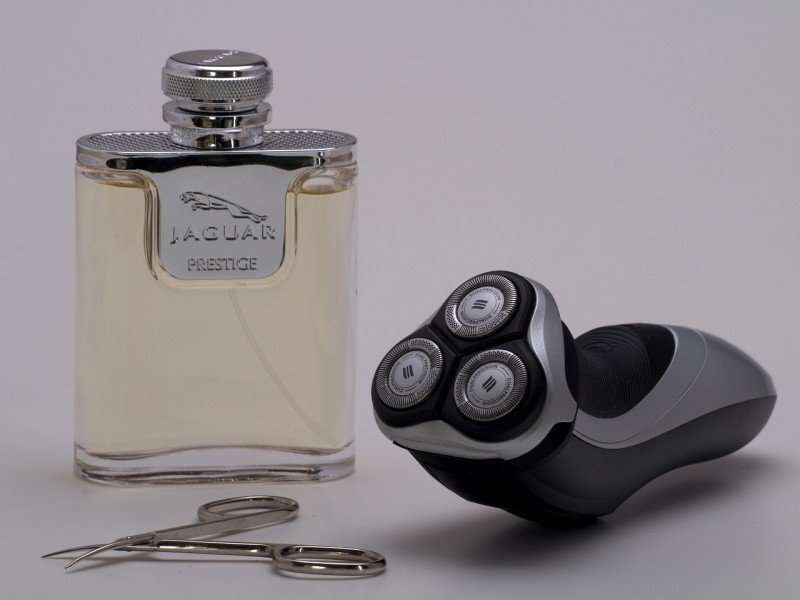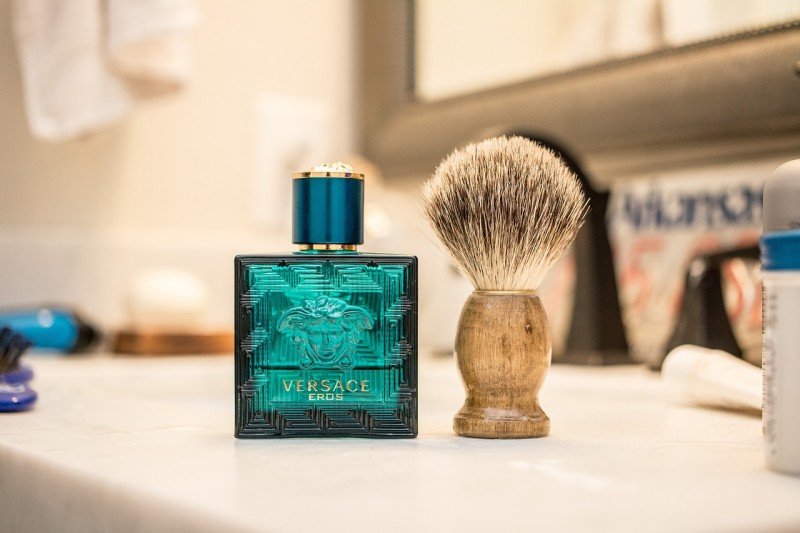You've nicked yourself shaving again, haven't you? We've all been there.
Don't fret, there's a myriad of quick-fix solutions to soothe and heal those pesky shaving cuts. Whether it's the magic of styptic pencils or the power of alum blocks, we're diving deep into the world of shaving wound care.
Let's explore the best natural and commercial remedies and find that perfect quick-fix solution you've been searching for.
Key Takeaways
- Styptic pencils are a quick and effective solution for stopping bleeding from shaving nicks and cuts due to their aluminum compounds and astringent properties.
- Alum blocks are astringent and antiseptic, making them a great option for stopping bleeding quickly and preventing infection in shaving wounds.
- Rinsing with cold water can constrict blood vessels, reduce inflammation, and hydrate the skin, all of which contribute to faster healing and a healthier appearance.
- Other remedies such as antiseptic creams, witch hazel, tea tree oil, apple cider vinegar, Vaseline, aloe vera gel, and Arnicare cream can also be effective in preventing infection, reducing inflammation, and promoting healing, but they should not replace medical treatment for more serious cuts or wounds.
The Magic of Styptic Pencils
You'll be amazed at how a styptic pencil can instantly stop bleeding from minor nicks and cuts. This seemingly magical tool is a vital part of every shaving kit, and understanding its components will allow you to fully grasp why it's so effective.
The primary ingredient in styptic pencils is an aluminum compound known as an alum block. Alum is a natural astringent, meaning it causes your skin's tissues to contract, effectively sealing off any minor wounds. Other common ingredients include titanium dioxide and paraffin, which aid in coagulation and ensure a smooth application.
Using a styptic pencil is simple. Just wet the tip a bit and apply it to the wound. You'll feel a sting, but don't worry, that's the astringent doing its job. The bleeding will stop, and within a few days, the nick will be healed with no scar to show for it.
Now, if you're not a fan of the sting or the chalky residue of styptic pencils, there are alternatives. Alum matchsticks offer similar benefits without the residue. They're disposable, so you won't have to worry about bacteria buildup. Liquid styptics, on the other hand, are perfect for larger cuts. They contain the same astringent properties but come with an applicator for a mess-free experience.
Understanding the Power of Alum Blocks
You've likely heard about alum blocks, but do you know the power they hold? When used correctly, their healing properties can swiftly stop bleeding from shaving nicks and cuts. However, it's crucial to understand their limitations to fully utilize this tool in your grooming regimen.
Alum Blocks' Healing Properties
You're going to find the healing properties of an alum block quite remarkable, especially when it comes to treating minor shaving nicks and cuts. Despite concerns around alum toxicity, it's worth noting that the use of alum blocks is deeply ingrained in many cultures, which attests to its safety and efficacy.
To add depth, consider these key points:
- Alum blocks have astringent properties, which help to stop bleeding quickly.
- They also possess antiseptic qualities that prevent infection.
- Using alum can tighten the skin, contributing to a smoother shave next time.
- Alum's cooling effect can soothe razor burns.
Usage and Application
In understanding the power of alum blocks, you're embracing tradition and applying a practical solution to shaving mishaps, providing comfort, and promoting skin health.
The crux of mastery here lies in perfecting application timing and tool sterilization. You'll want to apply the alum block immediately after shaving to benefit from its astringent and antiseptic properties. Wet the alum block with cold water, gently glide it over the shaved area, and let it sit for a minute or two before rinsing. This timing will maximize the healing process.
As for tool sterilization, rinse your alum block after each use and let it dry naturally. It's key to preventing bacterial growth. The combination of timing and sterilization will optimize your alum block usage.
Alum Blocks' Limitations
Despite the many benefits, there are a few limitations to using alum blocks, and you should be aware of them to avoid any potential skin issues. Alum toxicity, although rare, can happen if you use alum excessively, leading to skin irritation or even burns.
Here are some things to keep in mind:
- Not suitable for all skin types: Alum blocks can cause further dryness and irritation if you've sensitive or dry skin.
- Temporary fix: Alum blocks only provide momentary relief.
- Allergic reactions: Some people might experience an allergic reaction.
- Alum toxicity: Excessive use can lead to skin problems.
You can consider alum alternatives like witch hazel or aloe vera, which are gentler on the skin. Ensure you use these products correctly to achieve the best results and maintain your skin health.
The Impact of Cold Water on Shaving Wounds
When you nick yourself while shaving, applying cold water can significantly aid healing.
It's not just about comfort; the cold constricts blood vessels, which helps to stop bleeding more quickly.
Furthermore, the cooling effect can reduce inflammation and even speed up the healing time.
Cold Water Benefits
You'll find that rinsing with cold water can significantly reduce bleeding from shaving nicks and cuts, thanks to its vasoconstrictive properties. Besides, cold water is instrumental in maintaining the Hydration Importance and Skin Elasticity, two vital aspects of skin health.
To appreciate this, consider the following:
- Cold water tightens the skin, enhancing its elasticity and making it more resistant to injuries.
- It aids in hydration, which is essential for keeping the skin plump and resilient.
- Cold water helps soothe skin irritation, a common aftermath of shaving.
- Lastly, it reduces redness and puffiness, making your skin look healthier.
In your pursuit of mastery in skincare, understanding these benefits of cold water will significantly improve your routine, ensuring fewer shaving accidents and healthier skin.
Wound Healing Process
In your wound healing process, it's crucial to understand that cold water can play a key role in both reducing bleeding from shaving injuries and soothing the skin, yet it's not a cure-all solution. It's a quick fix but can't replace the body's natural healing mechanisms.
Your body's response to injury involves two key players: inflammation control and clotting factors. Inflammation is your body's initial response, mobilizing white blood cells to the injury site. Cold water can assist by constricting blood vessels, reducing both bleeding and inflammation.
Clotting factors, proteins in your blood, then work to form a protective scab. While cold water can't directly influence these, staying hydrated ensures your body has the necessary resources. Remember, hydration is crucial, but don't overlook professional medical advice.
The Efficacy of Antiseptic Creams
You've probably noticed that some antiseptic creams claim to kill 99.9% of germs, but it's important to remember that this doesn't necessarily mean they're the most effective option for treating shaving cuts. While these creams do possess antibacterial properties, they may not be the best choice for everyone.
Understanding the efficacy of antiseptic creams requires a closer look at the key factors:
-
Antibacterial properties: These are crucial in preventing infection. However, remember that your skin also has beneficial bacteria that these creams can wipe out.
-
Cream allergies: Some people are allergic to the ingredients in certain creams. Always check the label for potential allergens.
-
Healing process: Antiseptic creams can slow down the natural healing process of your skin. Your body has its own defenses that kick in when you get a cut or scrape.
-
Effect on skin: Some creams can dry out your skin, leading to itching or flaking.
Beyond these, it's crucial to follow a proper wound care routine. Always clean the cut with warm water and mild soap before applying any cream. If you're prone to nicks and cuts while shaving, consider switching to a safety razor or an electric shaver.
The Wonders of Witch Hazel in Aftershaves
Witch hazel is a natural ingredient in many aftershaves, and it's known for its soothing and healing properties. It's one of the best quick-fix solutions for accidental shaving nicks and cuts. But, have you ever wondered about witch hazel extraction methods or witch hazel's history? Let's delve into that.
The extraction process is straightforward yet requires precision. Witch hazel bark, leaves, and twigs are boiled to extract the active ingredients - mainly tannins and volatile oils. The steam is then cooled, condensed, and collected. This distillate is what's used in your aftershave. It's the tannins that work the magic by reducing inflammation and promoting healing.
Now, onto witch hazel's history. Native Americans were the first to discover the plant's medicinal properties. They used witch hazel to treat various ailments, including skin conditions. It didn't take long for early settlers to catch on, and by the 19th century, witch hazel was an integral part of the American pharmacopeia.
Fast forward to now, and you're part of this rich history every time you apply an aftershave with witch hazel. It's a testament to the plant's timeless efficacy. So, next time you're nursing a shaving nick or cut, reach for that witch hazel aftershave. Not only will you be soothing your skin, but you'll also be partaking in a centuries-old tradition of natural healing.
Tea Tree Oil: A Natural Solution for Shaving Injuries
Exploring the benefits of tea tree oil as a natural remedy for shaving injuries, you'll find it's an effective treatment with anti-inflammatory and antimicrobial properties. As a matter of fact, its potency against bacteria and fungi is well-documented, making it a popular ingredient in many skincare products.
But before you start applying it liberally, it's crucial to understand the potential for Tea Tree Oil Allergies and the importance of proper Dilution Ratios.
First, let's delve into the key benefits of tea tree oil:
- It's a natural antiseptic that can help prevent infections in minor cuts and nicks.
- It reduces inflammation, promoting faster wound healing.
- It possesses antimicrobial properties, discouraging bacterial growth.
- It soothes the skin, reducing redness and irritation post-shave.
However, tea tree oil is potent, and direct application can lead to skin irritation or allergic reactions in some individuals. Symptoms of Tea Tree Oil Allergies may include redness, itching, and swelling. That's where Dilution Ratios come into play. You should always dilute tea tree oil with a carrier oil, like almond or coconut oil. A recommended dilution ratio is typically 5% - meaning 5 parts tea tree oil to 95 parts carrier oil.
Exploring the Use of Apple Cider Vinegar and Vaseline
While you've learned about tea tree oil's benefits, it's time to consider apple cider vinegar and Vaseline as potential remedies for your shaving woes. Understanding these alternatives involves knowing their properties, application techniques, and potential outcomes.
Firstly, apple cider vinegar (ACV) is renowned for its antiseptic and astringent properties. These make it an excellent choice for vinegar disinfection methods when dealing with shaving nicks and cuts. To use ACV, dilute it in equal parts with water to avoid skin irritation. Apply the solution gently on the injured area using a clean cotton pad. The vinegar's acidity helps to kill bacteria, preventing infection while speeding up the healing process.
Vaseline, on the other hand, is celebrated for Vaseline's moisturizing effects. As a petroleum jelly, it forms a barrier that protects the skin, locks in moisture, and allows the skin to heal itself naturally. To leverage these benefits, cleanse the wound with mild soap and water, then pat dry before applying a thin layer of Vaseline. This method is best used for shallow cuts and abrasions that don't require stitches.
However, while both ACV and Vaseline offer promising results, it's crucial to remember that they're quick-fix solutions, not replacements for medical treatment. If your shaving injury is deep, doesn't stop bleeding, or shows signs of infection, seek immediate medical attention.
In the end, knowing your options and how to use them effectively makes you not only a master of your grooming routine but also a savvy handler of shaving mishaps.
Aloe Vera Gel and Homeopathic Arnicare Cream: Nature's Gift for Shaving Cuts
You've tried apple cider vinegar and Vaseline, but now let's dive into the healing potential of aloe vera gel and homeopathic Arnicare cream for your shaving cuts.
First, let's consider the 'Benefits of Aloe Vera Gel.' Aloe vera isn't simply a plant with a cooling effect. Its gel is packed with powerful enzymes, vitamins, and amino acids that promote skin regeneration. When applied to a shaving cut, it forms a protective layer that moisturizes the skin and boosts the healing process.
Next, let's explore the 'Homeopathic Arnica Cream Wonders.' Arnica Montana, the key ingredient in Arnicare cream, is a plant native to Europe and has long been used in homeopathic medicine. This cream reduces inflammation and pain, stimulates circulation, and accelerates wound healing.
To fully grasp the advantages these two products offer, consider the following:
- Aloe vera gel acts as an antiseptic, preventing infection in your shaving cuts.
-
It also reduces inflammation and accelerates skin cell regeneration.
-
Homeopathic Arnica cream not only reduces inflammation and pain but also prevents bruising.
- It promotes quicker healing by stimulating your body's natural healing mechanisms.
Frequently Asked Questions
What Is the Optimal Time to Apply Quick-Fix Solutions After a Shaving Cut?
You should apply quick-fix solutions immediately after a shaving cut. This will maximize healing and minimize scarring. But remember, proper cut-prevention techniques and shaving tool maintenance can help avoid these accidents in the first place.
Can These Quick-Fix Solutions Be Used for Cuts and Nicks Caused by Things Other Than Shaving?
You can use quick-fix solutions for cuts and nicks from other sources. The application techniques and alternative uses remain the same. However, always ensure it's suitable for the severity of your wound.
Are There Any Potential Allergic Reactions to Be Aware of When Using These Quick-Fix Solutions?
Yes, you could experience allergic reactions to quick-fix solutions. Look out for itching, redness, or swelling. To prevent allergic reactions, test a small amount on your skin before full application.
How Long Does It Typically Take for a Shaving Nick or Cut to Heal Using These Methods?
Using healing accelerators, you'll find most minor shaving nicks and cuts heal within 2-3 days. However, cut prevention techniques are key to avoid prolonging the healing process and potential scarring.
Can These Quick-Fix Solutions Be Used Alongside Other Treatments, or Should They Be Used Exclusively?
You're wondering about solution compatibility and exclusive usage. Generally, you can use quick-fix solutions alongside other treatments, but it's best to avoid mixing remedies to prevent potential adverse reactions. Always test on a small area first.
Our Last Thoughts
You've plenty of quick-fix solutions for accidental shaving nicks and cuts.
Styptic pencils and alum blocks can provide immediate relief. Cold water, antiseptic creams, and witch hazel aftershaves can also be beneficial. Natural remedies like tea tree oil, apple cider vinegar, aloe vera gel, and Arnica cream can soothe and heal your skin efficiently.
Choose the one that suits you best and keep it handy for a painless shaving experience.


